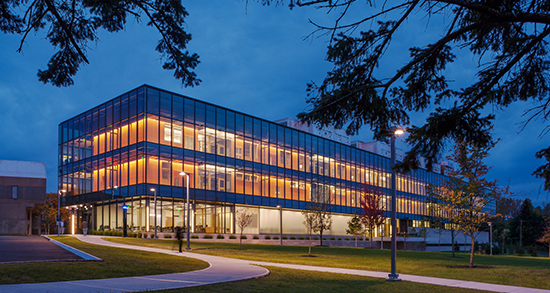We consistently work towards incorporating energy-saving tactics into the buildings we design. We are committed to energy-efficient spaces and reducing the environmental impact of each building.

This month we’re looking at Hudson Valley Community College’s Science Center, which opened last fall. The new Science Center, supported by Rensselaer County and the State of New York, helps Hudson Valley serve as a bridge between companies seeking skilled employees and those seeking training and employment. This 114,000 GSF undergraduate teaching facility includes classrooms, faculty offices, laboratories for biology with a greenhouse, chemistry, physics/geology, and a unique program component called technical services in which chemicals are prepared centrally and distributed to the classrooms by a small staff using a dedicated service corridor.
The Science Center was built on an existing parking lot, and is currently tracking LEED Gold. A glazed corridor wraps the building as a “blanket,” which acts as a thermal buffer, allowing solar heat gains to assist during the heating season, which is when the building is used most. A narrow footprint allows much of the building to be daylit, and internal automated blinds mitigate any discomfort due to glare.
The plant palette utilized in the planting design draws from native and regionally adapted species based upon the US Department of Agriculture, that are currently found thriving in the region without irrigation.
The site is located in the eastern region of New York State and the school is able to maintain lawns without automatic irrigation due to the annual precipitation rate of 37.9 inches and approximately 3.78 inches per month between June and September. The dryer western facing slope will be planted with low-maintenance native grasses that require little maintenance once established.
The school went to great lengths with a landscape contractor to dig, store and transplant many of existing trees before the beginning of construction on the project.

of site with adaptive and native plants including no-mow lawn, which eliminated any need for irrigation

of annual rainfall volume will be treated and re-used to operate the HVAC system.

total reduction of potable water due to low flow fixtures

of the spaces have access to daylight

energy savings overall due to “thermal blanket,” automated blinds and high performance HVAC


